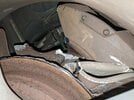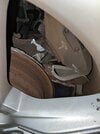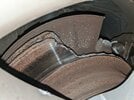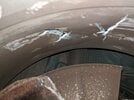My 2012 Model S (134k miles) popped up a message telling me that the parking brake had suddenly engaged while I was driving to work, luckily at only 20 mph in the neighborhood. (I did not press/hold the P button.) A few seconds later, as I was still deciding what to do with this information, I heard a loud crunch and bang. When I pulled over to look, my passenger rear brake rotor had shattered and crumpled, punching holes in the rim and tire and ripping off the calipers and part of the frame. I had to take it to a different Tesla service center than usual, and this new one barely communicated with me, wouldn't tell me what was going on, and was way off on their time and price estimates, ultimately charging me double what they initially quoted. I'm disappointed given the excellent service I had at a previous SC. This happened 7 months after I last had the car/brakes inspected. Since they wouldn't tell me anything, do any of you have any idea what happened here? Thanks.
Welcome to Tesla Motors Club
Discuss Tesla's Model S, Model 3, Model X, Model Y, Cybertruck, Roadster and More.
Register
Install the app
How to install the app on iOS
You can install our site as a web app on your iOS device by utilizing the Add to Home Screen feature in Safari. Please see this thread for more details on this.
Note: This feature may not be available in some browsers.
-
Want to remove ads? Register an account and login to see fewer ads, and become a Supporting Member to remove almost all ads.
You are using an out of date browser. It may not display this or other websites correctly.
You should upgrade or use an alternative browser.
You should upgrade or use an alternative browser.
TSLA Pilot
Active Member
Not sure why they're billing you for such a massive, and safety-related failure that should never have occurred.
Recommend you file a notice at NHTSA's website ASAP as it only takes a few minutes and will likely save some lives . . . you were damn lucky that occurred at only 20 mph. If it had occurred at freeway speeds, you may not be alive to write your post.
I remained boggled at how little Tesla Service seems to care about life-risking defects. The SC should have forwarded this failure to HQ within minutes of your arrival as if it happens to one, it could easily happen to far more than one.
Also consider the options of filing an insurance claim? Perhaps a rock became wedged in the rotor causing it to shatter . . . maybe?
Just curious:
1. What was the total cost to repair this mayhem?
2. What does the invoice report as to the cause, if anything?
Recommend you file a notice at NHTSA's website ASAP as it only takes a few minutes and will likely save some lives . . . you were damn lucky that occurred at only 20 mph. If it had occurred at freeway speeds, you may not be alive to write your post.
I remained boggled at how little Tesla Service seems to care about life-risking defects. The SC should have forwarded this failure to HQ within minutes of your arrival as if it happens to one, it could easily happen to far more than one.
Also consider the options of filing an insurance claim? Perhaps a rock became wedged in the rotor causing it to shatter . . . maybe?
Just curious:
1. What was the total cost to repair this mayhem?
2. What does the invoice report as to the cause, if anything?
Upvote
0
ucmndd
Well-Known Member
Warranties are not extended to “infinite years and miles, whichever comes first” through the simple act of clutching one’s pearls and screaming SAFETY.Not sure why they're billing you for such a massive, and safety-related failure that should never have occurred.
There’s no reasonable expectation that Tesla should foot the bill.
Upvote
0
Huachipato
Member
I see a rotor that looks well past it's prime and probably should have been replaced when they inspected it last time. The caliper breaking off... I don't believe I've seen that before.
If I were to guess what happened, I would say that the brake pad probably bit hard into the rotor and chewing off a chunk of the rotor and then a some small amount of movement caused the rest of the carnage.
If I were to guess what happened, I would say that the brake pad probably bit hard into the rotor and chewing off a chunk of the rotor and then a some small amount of movement caused the rest of the carnage.
Upvote
0
Those rotors look like they're rotted. I cannot believe 7 months ago they didnt tell you to replace them. I think maybe SC told the OP to replace them and he declined. I mean they look like there completely rusted out
Upvote
0
islandbayy
Active Member
That rotor looks like it should have been replaced a LONG time ago. That looks way too rusted, and thin. Even with the brake failure, it should not have cracked or shattered like that.
Heck, at my old shop, we had a worn out rotor welded onto an old pipe sticking out of the concrete to use as a make shift anvil, being hamered on fairly hard at times, when I took a drive by to visit my friend (the owner of the shop) it was still there still being used. I've never seen a rotor shatter like that.
If you just had a brake inspection, that SHOULD NOT have passed. I'd like to see more pictures of that.
In addition, by looks of whats left of the rotor, the pads were barely making contact with it. Likely just parking brake pads. Some major rust & metal fatigue due to it.
Heck, at my old shop, we had a worn out rotor welded onto an old pipe sticking out of the concrete to use as a make shift anvil, being hamered on fairly hard at times, when I took a drive by to visit my friend (the owner of the shop) it was still there still being used. I've never seen a rotor shatter like that.
If you just had a brake inspection, that SHOULD NOT have passed. I'd like to see more pictures of that.
In addition, by looks of whats left of the rotor, the pads were barely making contact with it. Likely just parking brake pads. Some major rust & metal fatigue due to it.
Upvote
0
TSLA Pilot
Active Member
Perhaps it’s because it’s a Tesla, but these sorts of catastrophic failures seem extremely uncommon in other circa-2012/13 vehicles….
Perhaps more color will revealed if everyone that has these events posts them to the US regulatory body, NHTSA.gov?

 www.nhtsa.gov
www.nhtsa.gov
Perhaps more color will revealed if everyone that has these events posts them to the US regulatory body, NHTSA.gov?

Report a Safety Problem | NHTSA
File a complaint with NHTSA if you experienced a vehicle, tire, car seat or equipment safety problem that could be a safety defect.
Upvote
0
ucmndd
Well-Known Member
I’d offer up that very few 10+ year old vehicles, particularly those used in harsh climates, still have their original brake rotors in place.Perhaps it’s because it’s a Tesla, but these sorts of catastrophic failures seem extremely uncommon in other circa-2012/13 vehicles….
The only surprise here is that if OP is to be believed, someone told them 7 months ago that those brakes were fine. They were not.
Upvote
0
TSLA Pilot
Active Member
All the more reason for a NHTSA investigation and subsequent recall—poor materials selection by Tesla back in 2012 perhaps?I’d offer up that very few 10+ year old vehicles, particularly those used in harsh climates, still have their original brake rotors in place.
The only surprise here is that if OP is to be believed, someone told them 7 months ago that those brakes were fine. They were not.
Upvote
0
zoomer0056
Active Member
I agree, such a catastrophic failure! The car is 12 years old with well over 100k miles. I would get the SC who did the brake job involved. Maybe they did something incorrectly, even as simple as not doing inspection before/after the job.Not sure why they're billing you for such a massive, and safety-related failure that should never have occurred.
Upvote
0
ucmndd
Well-Known Member
Tesla selected the same OEM basically everyone uses. Brakes wear out. Cast iron rusts. Especially in wet/salty climates like Oregon.All the more reason for a NHTSA investigation and subsequent recall—poor materials selection by Tesla back in 2012 perhaps?
This is a maintenance failure, not a safety crisis deserving of a recall. Any similar vintage car driven in similar conditions is highly likely to exhibit the same sort of wear.
Upvote
0
Like everyone else, I am curious about the recent brake inspection....do you have any documentation of this inspection that you could share with us? If there was no sign of corrosion damage to the caliper then it’s a lot of damage for just seven months....I would have thought a proper inspection would have advised a caliper rebuild. Do you have photos of the other calipers ?
Upvote
0
Homey was like it has regen, no need to ever use the brakes lol. Never changed the rotors in 10+ years, they rusted out and corroded, I'd bet anything he had to make a hard stop and those disintegrated brakes just gave out. Very dangerous for not spending a few hundred bucks
Upvote
0
Everyone waiting with baited-breath for OP to appear once again with details about said brake inspection.
And yes, claiming this is an inherent safety issue worthy of a recall is absurd. Catastrophic premature failures despite usual-and-customary required maintenance is one thing, but this example ain’t it. Fore links shearing off when backing out of a parking spot at 2 mph is.
The pics themselves show an uneven pad wipe area, so outside of the rust issue, the heat was not spread across the entire surface of the rotor, which could’ve hastened the crack/break.
Either way, pretty simple IMO. If an SC (hopefully this wasn’t PDX/Macadam as I’ve had great experiences with them since day one) did inspect the brakes 7mos ago and gave a clean bill of health, they should foot the bill now to make OP whole again. If it was “I recently bought this car and previous owner told me the inspection was done”…
And yes, claiming this is an inherent safety issue worthy of a recall is absurd. Catastrophic premature failures despite usual-and-customary required maintenance is one thing, but this example ain’t it. Fore links shearing off when backing out of a parking spot at 2 mph is.
The pics themselves show an uneven pad wipe area, so outside of the rust issue, the heat was not spread across the entire surface of the rotor, which could’ve hastened the crack/break.
Either way, pretty simple IMO. If an SC (hopefully this wasn’t PDX/Macadam as I’ve had great experiences with them since day one) did inspect the brakes 7mos ago and gave a clean bill of health, they should foot the bill now to make OP whole again. If it was “I recently bought this car and previous owner told me the inspection was done”…
Upvote
0
TSLA Pilot
Active Member
Well, perhaps the problem's solution lies in your statement above, "Tesla selected the same OEM basically everyone uses."Tesla selected the same OEM basically everyone uses. Brakes wear out. Cast iron rusts. Especially in wet/salty climates like Oregon.
This is a maintenance failure, not a safety crisis deserving of a recall. Any similar vintage car driven in similar conditions is highly likely to exhibit the same sort of wear.
The use case for brakes on any Tesla is far different from the use case in an ICE vehicle. YES, "brakes wear out." This is NOT "brakes wearing out" at all--on the contrary, this is a catastrophic failure mode that presented without warning in which lives could have been lost had it occurred at higher speed. Brakes that "wear out" present themselves (via IP warning and/or impossible to miss brake noises) far, far in advance of any degradation in braking, and well before any major brake component failures.
Is material selection an issue here? Perhaps likely to be causal, hence the request for the OP to file a NHTSA complaint to see how prevalent these failures are, and have them look into this failure more carefully. At worst, the oldest Model S is just over a decade old, not two or three decades old, which is what that one brake look like.
Brakes "wearing out" is expected, and this isn't that . . . .
Upvote
0
Similar threads
- Replies
- 3
- Views
- 2K
- Replies
- 7
- Views
- 707






